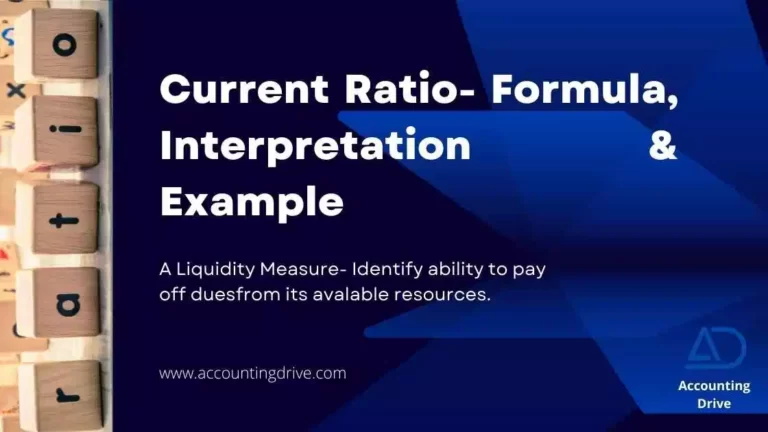If you wonder what is current ratio? How to calculate it? What is a good current ratio? And why good it is good for a company? Here we have addressed all these queries and tried to fade away all the question from your mind. Let’s begin with the definition.
Definition
In This Article
ToggleThe current ratio of a company identifies the ability of a company to pay its short-term financial obligations. You can calculate it by simply dividing the current assets from its current liabilities.
Formula
Current Ratio = Current Assets / Current Liabilities
- A way of measuring company’s financial condition.
- Good ratio : CR >1
- Bad ratio : CR <1
Interpretation
Here, you are provided deeper understanding of what is it? Current ratio of a company compares the current asset of a company to current liabilities. Similarly, to measure a company’s ability to pay its expenses or financial obligation we need to figure out company’s current ratio which in turn help us in figuring out the company’s financial condition.
What we need to know here is that if current ratio is greater than 1 it’s a good thing.
CR >1 where CA> CL
This means current asset of the company exceeds current liabilities of the company. That’s a good thing for you, you have owe more than what you have to pay.
However, if current asset is less than 1 this means current asset is less than current liabilities.
CR<1 where CA<CL
If the company’s liabilities exceeds its assets that is not a good sign but, if the company asset exceeds its liabilities that’s a good sign. So make sure your current liabilities don’t exceeds your current assets for the betterment of your company financial condition.
Moreover, you know, you can calculate working capital as well with the help of current assets and current liabilities just subtract current liabilities from current assets.
What is a Good Current Ratio?
CR >1
When the current ratio is more than one it indicates a good ratio. The question may arise in your mind how it’s a good ratio? So, here we have elaborated all the quires to make things crystal clear. Just read ahead!
CURRENT ASSET > CURRENT LIABILITIES
A good current ratio is when the assets of a company exceed its liabilities. It is not difficult to understand why it is considered the best ratio because we have more assets than our liabilities. In other words, we owe more than what we have to pay. For instance, if you are running a business, the assets you have all together are worth $100 million but the liabilities you have to pay are $200 million. In this way, you have to pay more than what you have which is not a good sign for your company. Moreover, if you are running a business and the assets you have worth $400 million but the liabilities that you need to pay off our $200 million which is less than $400 million this is a good sign for your company because you don’t have to pay more than what you have.
In this way, if the current asset is less than 1 it is a bad sign. On the other hand, if the it is more than 1 it is a good sign.
Example
Let’s talk about an example that is going to illustrate the current ratio. Here we’ll compare two companies. Ok, so let’s assume that company A has Six million dollars in currents assets. Furthermore, Company B also possess six million dollars in its current assets. Company A has four million in current liabilities. However, company B has EIGHT million in currents liabilities. To calculate current ratio of a company we need to divide the current assets to liabilities of the respective company.
| Company A | Company B |
CURRENT ASSETS | $600 / | $600 / |
CURRENT LIABILITIES | $400 | $800 |
CURRENT RATIO | = 1.5 | = 0.75 |
| CA > CL | CL > CA |
Company A
From this example we can clearly see that the current assets of company A exceeds the current liabilities. Company A has $600 million dollars in its assets which is greater than $400 million dollars. Likewise, we can see that the current ratio is above 1 which is a good sign for a company.
CA > CL
Company B
On the other hand, if we take into account the current ratio of company B it is quite evident that the current liabilities of company B exceeds its assets. Company B has $600 million in its current assets while the current liabilities are $800 million. Therefore, we can see that the current ratio is below 1 which is not a good sign for a company. So, it is not a good thing to owe more than what you have.
CL> CA
Find it difficult to calculate current ratio? No worries! For your convenience, here is a free template for you to calculate current ratio where you have to only put values of current assets and current liabilities. Download your free current ratio excel template now.
Difference Between Quick Ratio and Current Ratio
Before rushing towards the difference between both here you are given a short explanation of what is quick ratio. Quick ratio in another liquidity ratio. Quick ratio also help us in measuring the financial ability of a company to pay its financial obligation.
The quick ratio is equal to liquid assets of a company minus inventory divided by current liabilities. The inventory is an asset but not a liquid asset, why? Because if the company has to sell the inventory quickly it may have to offer a discount. So, it takes more time to sell. Therefore, it is not a liquid asset.
Formula
Quick Ratio = Quick Assets / Current Liabilities
You can calculate quick ratio in two ways.
| Quick Assets |
1. | Current assets – inventory – Prepaid expenses |
2. | Cash & cash equivalent + Marketable securities + Account Receivable |
Let’s understand it with the help of example.
XYZ Company has $400 million in current asset, the inventory costs 50 million. While the liabilities which it need to pay off are $300 million.
Quick ratio = CA / CL
= (400 – 50)/300
= 350/300
= 1.16
So, the quick ratio here is above 1 which is a good sign for the company. As you want the current assets to exceed the current liabilities. That means the company can easily pay off its financial obligation through its current assets.
Quick Ratio vs Current Ratio
Let’s have a look at the difference between quick ratio vs current ratio. We can easily distinguish between two by looking at their formula.
In current ratio, we divide current assets by current liabilities. To calculate current assets you should add all those asset that can easily be convertible into cash within one year period. It includes cash & cash equivalent, accounts receivable, inventory, prepaid expenses, and other current assets. Moreover, current liabilities are also those liabilities that are payable within one year. Thus, it includes accounts payable, notes payable, and accrued liabilities.
While in quick ratio, we need to minus the inventory and prepaid expenses from the current assets and then we divide it by current liabilities. Quick assets are those assets that are readily convertible into cash within one or two months. Quick assets includes cash and cash equivalent, accounts receivable and marketable securities.
Current Ratio | Quick Ratio |
Current Ratio = Current Assets / Current Liabilities | Quick Ratio = Quick Assets / Current Liabilities |
Balanced Ratio= Ratio greater than 1 | Balanced Ratio= Ratio greater than 1 |
Key Points
- The current ratio of a company identifies the ability of a company to pay its short-term financial obligations.
- To calculate, just divide current assets from its current liabilities.
- When it is more than one it` indicates a good ratio.

